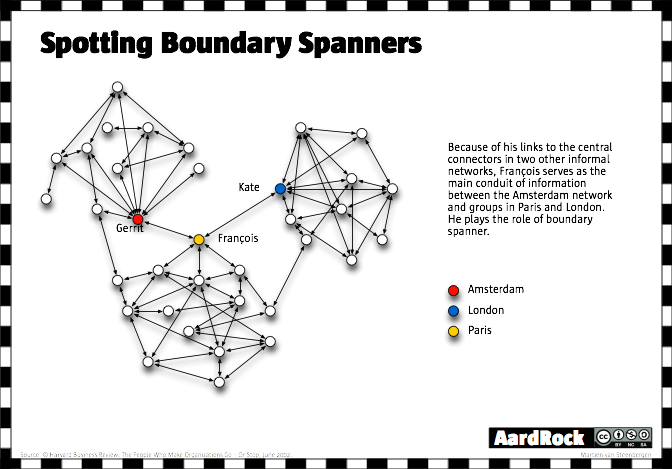Boundary Spanner
Description
"Boundary Spanning" was probably popularized by Richard L. Daft in 1989, in his book "Organizational Theory and Design"[1]. In that book, it was an concept being applied to organizational development.
Daft basically was describing a person who's role was linking people in organizations, across the "boundaries" of departments, and across the boundaries if companies themselves. The "linking" is really information exchanging, relationship building, and using "boundary objects" as a focal point to create shared meaning and trust across "boundaries".
Boundary spanners are a vital missing component in connecting practical theories and knowledge with real world applications.
Discussion
Testing Theory Through Action
"Boundary Spanners" would help putting theory into action by helping to build "Loose coupling"[2] between many different types of organizations, such as open networks like BarCamp, traditional organizations, government entities, companies, and people out there who have problems that need solving.
The emerging way in which this is working is:
- 1. Going to the place where the problems are, finding out what the actual problems are
- 2. Creating a very basic model for how to solve the problem, how to secure resources, etc
- 3. Communicating and connecting a diverse set of groups and individuals', and assessing who can contribute what, and giving the group of people, and those with the problem, a voice and a hand, in solving the problem.
- 4. Creating a shared understanding, and establishing trust among those involved
The beginning point is with the actual problems themselves. When real-world problems are the focus, it often becomes apparent that building blocks and resources (in the form of surpluses, etc), and knowledge/expertise already exist. So, in the case of Collective Problem Solving, the "Boundary spanner" job is really that of being the orchestrator of a process network. The "boundary spanner" also does the job of researching and developing (or coordinating research and development) of new ways to solve the problem.
Approaching Problems As A Unique Set Of Local Conditions
Each problem is unique, although meta-patterns do emerge in problems. Each local set of circumstances is unique, and each problem should be approached as a unique set of local conditions.
Key Conditions That Must Be Addressed
- 1. Create the framework for shared meaning among all of these people (sometimes done by using "boundary objects", like the problem itself as a "boundary object" with many facets of factors that must be addressed by the diverse group of people involved
- 2. Create a framework for real trust among the people involved. This is done through transparency, cooperative decision making, assurance of reciprocity, and open communications.
- 3. Evaluate, coordinate and orchestrate the people, resources, and talents, to assemble and apply the available technological/social/knowledge building blocks to solve the problem.
This approach can also work when trying to connect traditional hierarchically-organized entities with more laterally connected networks (like traditional companies that work directly with open source software projects, etc).
Notes
1. Daft, R. L. (1989). Organization Theory and Design (3rd ed.), New York: West Publishing Co.
2. Loose coupling describes a resilient relationship between two or more systems or organizations with some kind of exchange relationship. Each end of the transaction makes its requirements explicit and makes few assumptions about the other end. source: http://en.wikipedia.org/wiki/Loose_coupling
